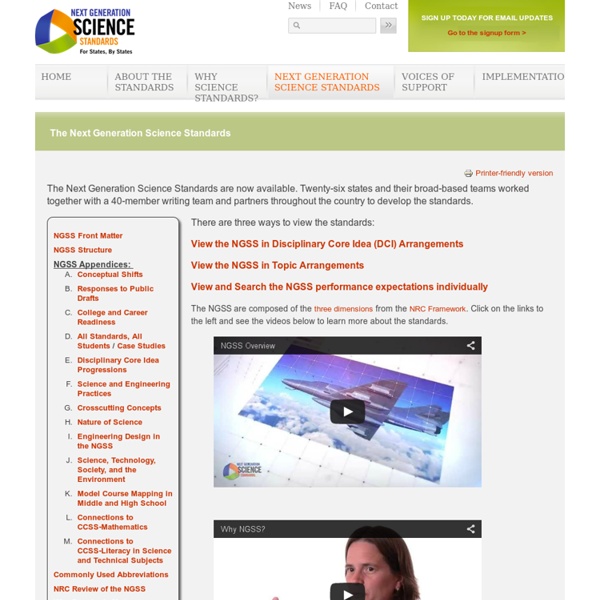



http://www.nextgenscience.org/next-generation-science-standards
Science National Research Council's Role "The National Research Council was organized by the National Academy of Sciences in 1916 to associate the broad community of science and technology with the Academy's purposes of furthering knowledge and advising the federal government. Functioning in accordance with general policies determined by the Academy, the Council has become the principal operating agency of both the National Academy of Sciences and the National Academy of Engineering in providing services to the government, the public, and the scientific and engineering communities. The study was supported by the National Science Foundation, the U.S. Department of Education, the National Aeronautics and Space Administration, the National Institutes of Health, and a National Academy of Sciences president's discretionary fund provided by the Volvo North American Corporation, The Ettinger Foundation, Inc., and the Eugene McDermott Foundation."
Properties of Water For example, on the top of Mt. Everest water boils at about 68 degrees Celsius, compared to 100 degrees at sea level. Conversely, water deep in the ocean near geothermal vents can reach temperatures of hundreds of degrees and remain liquid. [edit] Water in industry
for Education Schools and universities around the world are embracing audioBoom as the easiest, most effective way to give teachers and students a voice. Audio enriches the curriculum, engages the learner, and creates conversations that build community. Take a look at some amazing ways that audioBoom is reinventing the classroom experience. Give Your Students A Voice Your students have a lot to say! The Science Behind Clouds – On a Cloudy Day You Can See Weather Have you ever wondered how clouds form? We all learn the water cycle in school – water falls from the clouds in the form of rain or snow and collects on the ground. The water on the ground heats up and turns to vapor and the vapor travels up into the atmosphere and creates clouds. But how do those clouds form? Here’s an experiment that demonstrates how the water molecules join together and form a cloud. Before you start on your own cloud, let’s learn a little more about clouds.
Safety in Elementary School Science XII. Safety in Elementary School Science Keys to Safety: Planning, Management, and Monitoring Print Version (40 KB Acrobat) This chapter provides information to assist the elementary school teacher in maintaining a safe classroom environment for the teaching of science. Easy Science Experiments Hands-on science experiments at home or in the classroom are a fun way to engage kids and get them excited about science. Today’s sites house hundreds of easy experiments that can be done with supplies that you probably have around the house, or can get at the grocery store. Exploratorium: Science Explorer5 stars"Get messy, get airborne, get loud, get shocked!" San Francisco's Exploratorium hands-on science museum offers a sampler of thirty simple experiments excerpted from two "Science Explorer" books. Elsewhere they provide a hundred more experiments called "snacks" because they are both fun and easy. The Science Snacks are organized by category, or listed alphabetically on a single page (where you can use your browser search function to find something specific.)
Power electronics An HVDCthyristor valve tower 16.8 m tall in a hall at Baltic Cable AB in Sweden A PCs power supply is an example of a piece of power electronics, whether inside or outside of the cabinet Power electronics is the application of solid-state electronics for the control and conversion of electric power. Universities join hands to reach out to rural youth The Central University of Tamil Nadu (CUTN) at Thiruvarur and Tamil Nadu Agricultural University (TNAU) have tied up to offer agriculture-related short-term courses to farmers, who have not finished school, to give them an opportunity to equip themselves with the latest in farm technology. These courses will be offered in the community college mode at the CUTN. A memorandum to this effect was inked by B.P. Sanjay, Vice-Chancellor of CUTN, and K.
Elementary Curriculum Resources Energy Infobooks are the resource for many NEED activities and include an introduction to energy, information on major sources of energy, new technologies, energy conservation, electricity, climate change, and other energy information. They are available on four reading levels and are revised and updated annually. Blueprint for Success (e-publication) This essential gusdide helps educators develop effective energy education programs. Ohio Dep. Education Revised Science Stand. The State Board of Education has adopted the more rigorous Ohio Revised Science Content Standards as part of Ohio's New Learning Standards for academic learning. The Kindergarten - Grade 12 Ohio's New Learning Standards will be fully in use in Ohio classrooms by 2014-2015, when assessments that align to the standards are in place. ODE encourages districts to start implementing these Ohio New Learning Standards in Science now to better prepare students for 2014-2015 and beyond. Achieve released April 9, 2013, the final version of the Next Generation Science Standards (NGSS). As a lead state in the national initiative, Ohio will review the document to determine what future action should be taken.
No homework in Finland. See this hat? Tis' my cat. SCORE 135 The Students' Educational and Cultural Movement of Ladakh (This section was last updated in February 2014). SECMOL welcomes volunteers, their work and the inter-cultural exchange and understanding they bring. Conversation class SCORE - South Central Organization of Researchers and Educators (Space Science, Education and Public Outreach Lunar and Planetary Institute About SCORE Information for Community Workshops News
Kristen's Kindergarten I have also created Inquiry Based Lessons for other topics, as well as link them with the Reading A-Z readers or created a reader of my own. Along with each lesson, I created a pre and post test rubric so you can measure students’ growth. Each rubric is quick! It contains 3 learner outcomes that can be measured in various ways (through conversation, observation, etc.) and recorded on a scale of 1-5, so growth can be charted.